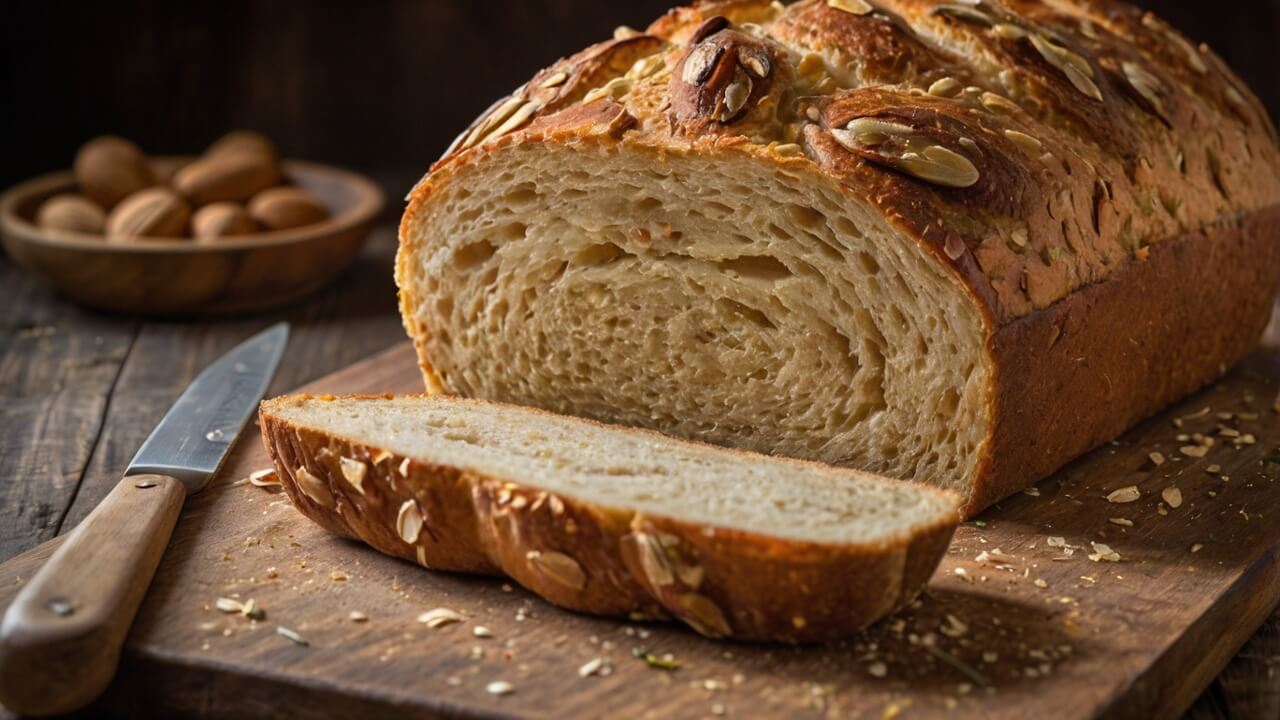Sourdough bread, with its tangy flavor and chewy texture, has long been a beloved staple in many households. However, for those following gluten-free, low-carb, or grain-free diets, traditional sourdough recipes can be off-limits.
Enter almond flour sourdough bread – a delicious and nutritious alternative that caters to various dietary preferences while preserving the essence of this beloved baked good.
Almond flour, made from finely ground almonds, offers a wealth of benefits. It’s naturally gluten-free, low in carbohydrates, and rich in healthy fats, fiber, and protein.
When incorporated into sourdough bread, almond flour lends a nutty flavor and tender crumb, making it a versatile ingredient for those seeking alternative baking options.
In this comprehensive guide, we’ll explore three distinct almond flour sourdough bread recipes, each tailored to specific dietary needs:
- Low-Carb Keto Sourdough Bread: This recipe is a game-changer for those following a ketogenic or low-carb lifestyle, allowing you to enjoy the comforting taste of sourdough while staying within your carb limits.
- Grain-Free Sourdough Bread: Perfect for those with grain sensitivities or preferences, this recipe uses almond flour as the sole flour source, creating a delicious and satisfying bread without any grains.
- Traditional Sourdough with Almond Flour: For those seeking a unique twist on classic sourdough, this recipe incorporates almond flour alongside traditional wheat flour, resulting in a bread with a delightful nutty flavor and enhanced nutritional profile.
Whether you’re embracing a specific dietary lifestyle or simply looking to explore new flavors and baking techniques, almond flour sourdough bread offers a delicious and versatile option.
Get ready to embark on a journey of alternative baking, where creativity meets nutrition, and the comforting aroma of freshly baked sourdough fills your kitchen.
What is Almond Flour?
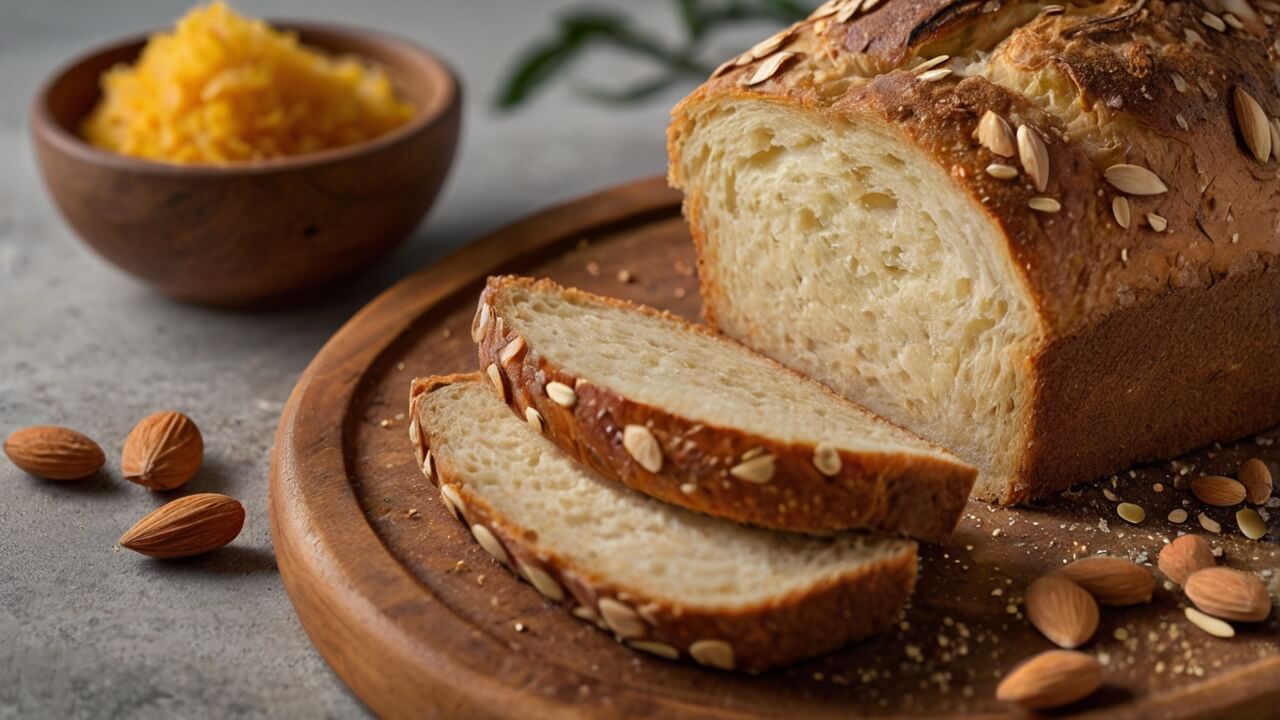
Almond flour is a nutrient-dense, gluten-free alternative to traditional wheat flour, made by grinding blanched almonds into a fine powder.
Unlike regular flour, almond flour is low in carbohydrates and high in healthy fats, fiber, and protein, making it an excellent choice for those following low-carb, keto, or gluten-free diets.
Properties of Almond Flour:
- Texture: Almond flour has a finely ground, yet slightly gritty texture, which contributes to a delightfully nutty and crumbly crumb in baked goods.
- Flavor: With its rich, buttery taste and aroma, almond flour imparts a distinct nutty flavor to recipes, enhancing the overall taste experience.
- Gluten-Free: Being derived from almonds, almond flour is naturally gluten-free, making it a safe option for those with gluten intolerances or celiac disease.
Nutritional Value:
Almond flour is a powerhouse of essential nutrients, including:
- Healthy Fats: Almonds are rich in monounsaturated fats, which are known to promote heart health and aid in nutrient absorption.
- Protein: With a higher protein content than regular flour, almond flour helps promote satiety and supports muscle growth and repair.
- Fiber: Almond flour is an excellent source of dietary fiber, which supports digestion and helps regulate blood sugar levels.
- Vitamins and Minerals: Almonds are packed with essential vitamins and minerals, such as vitamin E, magnesium, and potassium.
Benefits Over Regular Flour:
Compared to traditional wheat flour, almond flour offers several advantages:
- Low in Carbohydrates: Almond flour is significantly lower in carbohydrates than wheat flour, making it an excellent choice for those following low-carb or ketogenic diets.
- Gluten-Free: For individuals with gluten sensitivities or celiac disease, almond flour provides a safe and delicious alternative to wheat-based products.
- Nutrient-Dense: With its high content of healthy fats, protein, fiber, and essential vitamins and minerals, almond flour is a more nutritious option than refined wheat flour.
- Versatile: Almond flour can be used in a variety of baked goods, from breads and pastries to pancakes and pizza crusts, offering a wide range of culinary possibilities.
By incorporating almond flour into your sourdough bread recipes, you can enjoy a delicious and nutritious alternative to traditional bread while catering to various dietary preferences and health goals.
The Role of Almond Flour in Sourdough Baking

Almond flour brings a unique set of characteristics to sourdough bread, influencing the texture, flavor, rise, moisture, and shelf life of the final product.
Unlike traditional wheat flour, almond flour is gluten-free and low in carbohydrates, making it an excellent choice for those following a ketogenic, gluten-free, or grain-free diet.
Effects on Texture:
Almond flour contributes to a denser and more compact crumb structure in sourdough bread. Its lack of gluten, the protein responsible for the elastic and chewy texture in wheat-based breads, results in a more tender and crumbly texture. However, when combined with other ingredients like eggs or psyllium husk, almond flour can achieve a surprisingly bread-like texture.
Flavor Impact:
One of the most notable effects of almond flour is the rich, nutty flavor it imparts to sourdough bread. The natural oils and proteins in almonds lend a distinct aroma and taste, complementing the tangy notes of sourdough fermentation. This unique flavor profile adds depth and complexity to the bread, making it a delightful experience for the taste buds.
Rise and Structure:
Due to the absence of gluten, almond flour sourdough breads tend to have a denser structure and may not rise as much as traditional wheat-based loaves. However, incorporating techniques like folding and proper fermentation can help improve the rise and create a more open crumb structure. Additionally, using a combination of almond flour and other gluten-free flours or starches can enhance the bread’s overall structure.
Moisture Retention:
Almond flour has a higher fat content compared to wheat flour, which contributes to better moisture retention in sourdough bread. This characteristic helps keep the bread moist and fresh for a longer period, reducing the risk of it drying out quickly. However, it’s essential to balance the moisture levels by adjusting the hydration and incorporating ingredients like eggs or psyllium husk to achieve the desired texture.
Shelf Life:
Thanks to its natural oils and lack of gluten, almond flour sourdough bread tends to have a longer shelf life than traditional wheat-based loaves. The absence of gluten minimizes the risk of staling, while the natural oils in almond flour act as a preservative, helping to keep the bread fresh for several days. Proper storage techniques, such as using an airtight container or bread box, can further extend the shelf life.
By understanding the unique properties of almond flour and its effects on sourdough bread, bakers can create delicious and nutritious loaves that cater to various dietary needs and preferences. Embracing almond flour in sourdough baking opens up a world of possibilities for those seeking gluten-free, low-carb, or grain-free alternatives without sacrificing flavor or texture.
Low-Carb Keto Sourdough Bread with Almond Flour

Ingredients:
- 1 1/4 cups (140g) blanched almond flour
- 1/4 cup (30g) ground golden flaxseed
- 1/4 cup (30g) psyllium husk powder
- 1 tsp (5g) salt
- 1 tsp baking powder
- 1 cup (240ml) warm water
- 1/4 cup (60g) active sourdough starter
- 1 egg white, beaten (for egg wash)
Instructions:
- In a large bowl, whisk together the almond flour, flaxseed, psyllium husk powder, salt, and baking powder until well combined.
- Create a well in the center of the dry ingredients and pour in the warm water and sourdough starter. Using a wooden spoon or your hands, mix the wet and dry ingredients together until a shaggy dough forms.
- Turn the dough onto a clean surface and knead for 2-3 minutes until it becomes smooth and elastic. The dough should be slightly sticky but not overly wet.
- Place the dough in a greased bowl, cover with a damp towel, and let it rise for 6-8 hours at room temperature.
- Once the dough has doubled in size, punch it down to release air bubbles. Shape the dough into a round loaf and place it on a parchment-lined baking sheet.
- Use a sharp knife or lame to score the top of the loaf with a decorative pattern. Brush the top with the beaten egg white for a glossy finish.
- Preheat your oven to 375°F (190°C).
- Bake the bread for 30-35 minutes, or until the crust is golden brown and the internal temperature reaches 205°F (96°C).
- Remove the bread from the oven and let it cool completely on a wire rack before slicing.
Tips:
- For best results, use a kitchen scale to measure the ingredients precisely.
- If the dough seems too dry, add a tablespoon of warm water at a time until it reaches the desired consistency.
- Allow the dough to rise slowly for maximum flavor development.
- Brush the loaf with egg white or melted butter for a shiny, golden crust.
- Store the bread in an airtight container at room temperature for up to 5 days or freeze for longer storage.
Nutritional Information (per slice):
- Calories: 120
- Total Carbs: 6g
- Net Carbs: 3g
- Fiber: 3g
- Protein: 5g
- Fat: 9g
This low-carb, keto-friendly sourdough bread is perfect for those following a ketogenic or low-carb lifestyle. With its nutty flavor and satisfying texture, it’s a delicious alternative to traditional bread that won’t kick you out of ketosis.
Grain-Free Sourdough Bread with Almond Flour
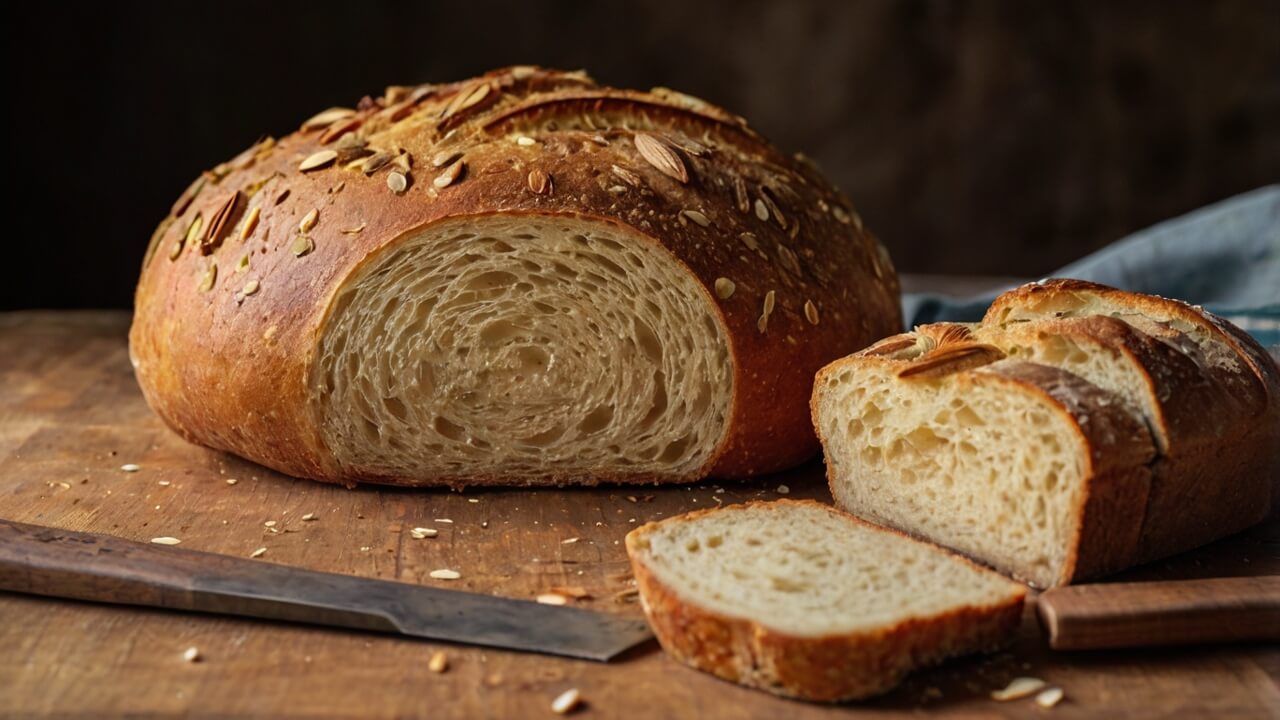
For those following a grain-free lifestyle, this almond flour sourdough bread recipe is a game-changer. Enjoy the tangy flavor and chewy texture of traditional sourdough without compromising your dietary needs.
Ingredients:
- 1 cup (120g) blanched almond flour
- 1/2 cup (60g) arrowroot flour
- 1/4 cup (30g) psyllium husk powder
- 1 tsp sea salt
- 1 tsp baking soda
- 1 cup (240g) grain-free sourdough starter
- 1/2 cup (120ml) warm water
- 2 large eggs, at room temperature
- 2 tbsp apple cider vinegar
- 2 tbsp avocado oil or melted coconut oil
Instructions:
- In a large bowl, whisk together the almond flour, arrowroot flour, psyllium husk powder, salt, and baking soda.
- Create a well in the center and add the sourdough starter, warm water, eggs, apple cider vinegar, and oil.
- Using a wooden spoon or spatula, gradually incorporate the dry ingredients into the wet ingredients until a shaggy dough forms.
- Turn the dough onto a clean surface and knead for 2-3 minutes until smooth and elastic.
- Place the dough in a greased loaf pan and smooth the top with wet hands.
- Cover the pan with a damp towel and let the dough rise for 8-12 hours at room temperature.
- Preheat your oven to 350°F (175°C).
- Bake the loaf for 40-50 minutes, or until a toothpick inserted in the center comes out clean.
- Remove the bread from the oven and let it cool completely on a wire rack before slicing.
Troubleshooting:
- If the dough seems too dry, add a tablespoon of water at a time until it comes together.
- If the dough is too sticky, dust your hands and the surface with almond flour while kneading.
- For a crunchier crust, spritz the loaf with water before baking.
Grain-Free Sourdough Starter Tips:
Creating a grain-free sourdough starter can be challenging, but with patience and persistence, it’s achievable. Here are some expert tips:
- Use a combination of almond flour and arrowroot flour as the base for your starter.
- Feed your starter regularly with equal parts flour and warm water.
- Maintain a warm, consistent temperature (around 75-80°F) for optimal fermentation.
- Be patient! It may take up to two weeks for your starter to become active and bubbly.
- Once established, store your starter at room temperature and feed it daily or refrigerate it for longer-term storage, feeding it weekly.
Enjoy this delicious, grain-free sourdough bread as a nutritious addition to your diet or as a tasty accompaniment to soups, salads, and more!
Traditional Sourdough with Almond Flour
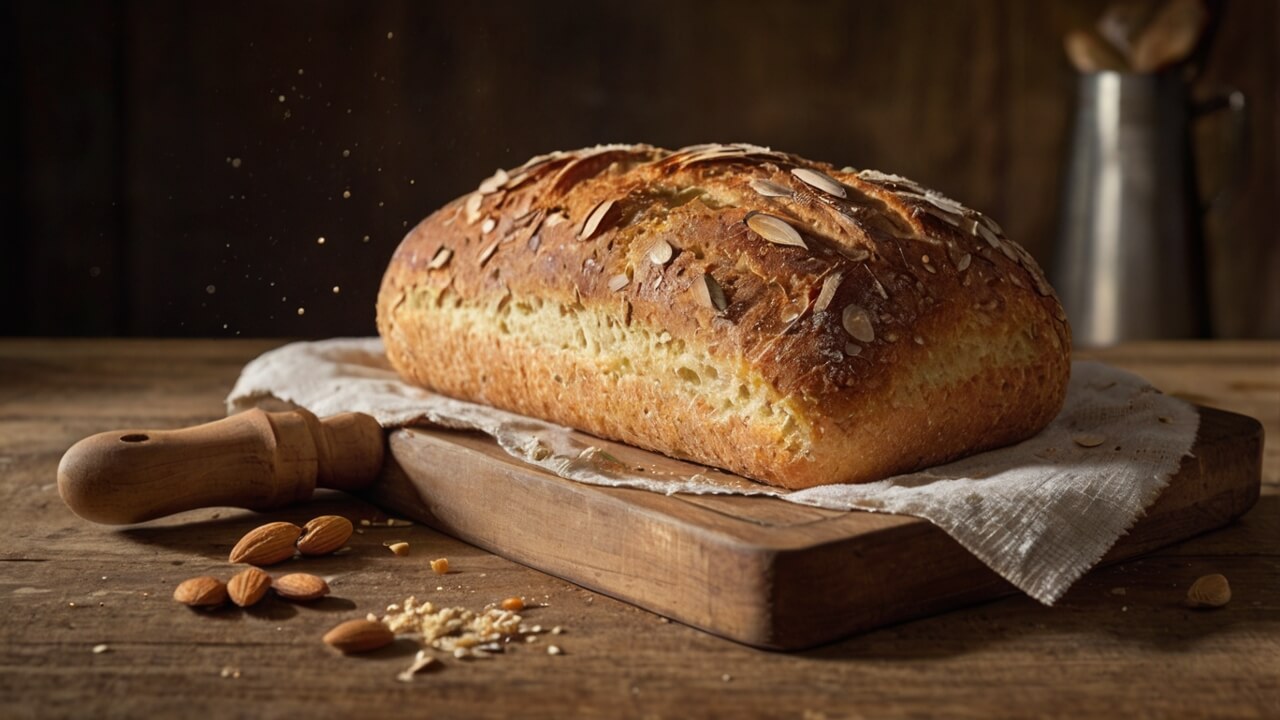
While almond flour is a fantastic gluten-free and low-carb alternative, it can also be incorporated into traditional sourdough bread recipes to enhance the flavor and nutritional profile. This recipe combines the beloved taste of classic sourdough with the nutty richness of almond flour, creating a unique and delightful bread experience.
Ingredients:
- 1 cup (120g) almond flour
- 3 cups (360g) bread flour
- 1 cup (240ml) warm water
- 1 tsp (6g) salt
- 1/2 cup (120g) active sourdough starter
Instructions:
- In a large bowl, whisk together the almond flour, bread flour, and salt.
- Create a well in the center and pour in the warm water and sourdough starter.
- Using a sturdy spoon or your hands, gradually incorporate the dry ingredients into the wet ingredients until a shaggy dough forms.
- Turn the dough out onto a lightly floured surface and knead for about 10 minutes, until smooth and elastic.
- Place the dough in a lightly greased bowl, cover with a damp towel, and let it rise for 8-12 hours at room temperature.
- Once doubled in size, punch down the dough to release air bubbles.
- Shape the dough into a round loaf and place it in a parchment-lined bowl or banneton for the final rise, about 1-2 hours.
- Preheat your oven to 450°F (230°C) with a Dutch oven or baking stone inside.
- Once preheated, carefully transfer the dough to the hot Dutch oven or baking stone.
- Bake for 20 minutes with the lid on, then remove the lid and bake for an additional 20-25 minutes, until deeply golden brown.
- Remove the bread from the oven and let it cool completely on a wire rack before slicing.
Balancing Flavors and Fermentation Tips:
- The almond flour contributes a rich, nutty flavor that complements the tanginess of the sourdough. However, it’s essential to strike the right balance to avoid overpowering the classic sourdough taste.
- Adjust the ratio of almond flour to bread flour based on your preference. For a more pronounced almond flavor, increase the almond flour amount slightly.
- Extend the fermentation time for a deeper, more developed sourdough flavor. The longer fermentation allows the natural yeasts and bacteria to work their magic, creating a more complex and tangy taste.
- Consider adding a small amount of honey or maple syrup to the dough to balance the nutty flavors and enhance browning during baking.
- Experiment with different sourdough starter ratios to find the perfect balance of sourness and rise for your almond flour sourdough loaf.
By incorporating almond flour into traditional sourdough bread, you’ll create a unique and flavorful loaf that combines the best of both worlds – the rich nuttiness of almonds and the beloved tanginess of sourdough. Embrace the experimentation and enjoy the delicious results!
Expert Tips for Perfect Almond Flour Sourdough Bread
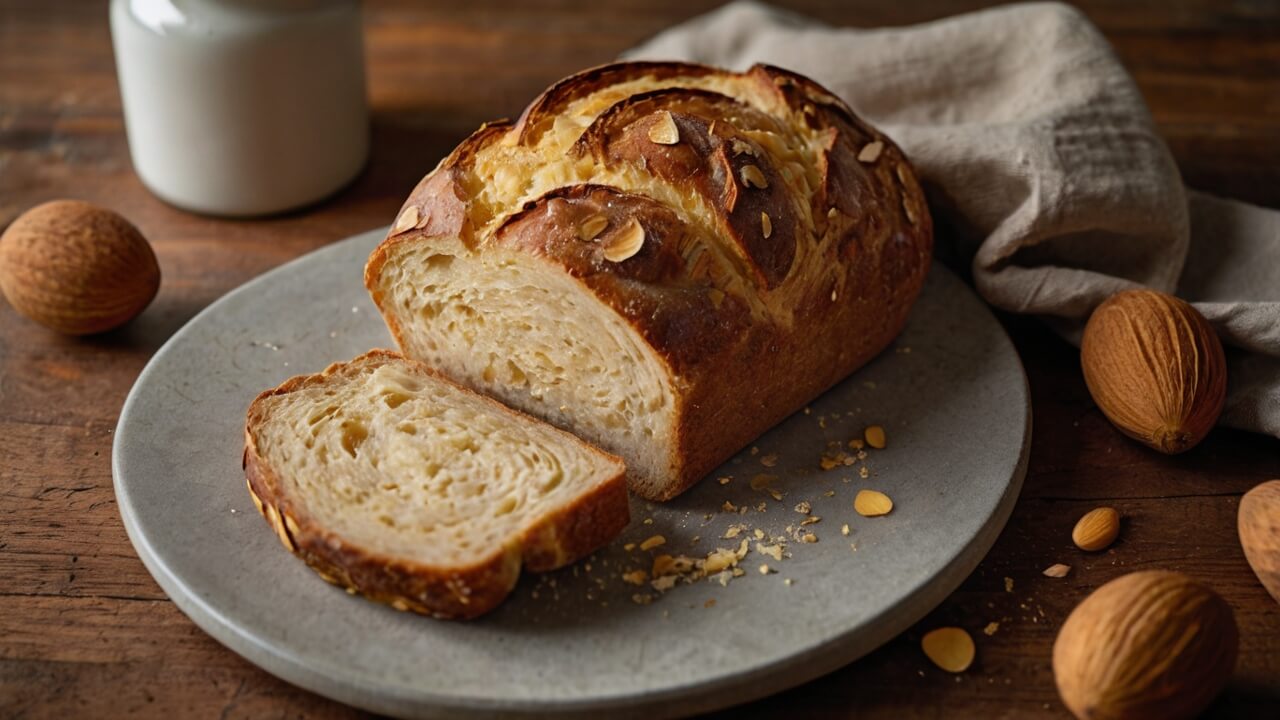
Baking with almond flour in sourdough bread can present some unique challenges, but armed with the right knowledge and techniques, you can achieve outstanding results every time. Here are some expert tips to help you master the art of almond flour sourdough bread:
Common Challenges and Solutions
Dry or Crumbly Texture: Almond flour is naturally drier than wheat flour, which can lead to a crumbly or dry texture in your sourdough. To combat this, increase the amount of liquid in your recipe, use a higher hydration level, or add ingredients like eggs, yogurt, or applesauce to enhance moisture.
Dense or Compact Crumb: Without the gluten structure provided by wheat flour, almond flour sourdough can sometimes turn out dense or compact. To achieve a lighter, more open crumb, consider incorporating a small amount of psyllium husk powder or xanthan gum, which can help bind the dough and create a more airy texture.
Lack of Rise: Almond flour doesn’t contain the same rising agents as wheat flour, which can result in a flatter loaf. To encourage a better rise, ensure your sourdough starter is active and bubbly, and consider using a longer proofing time or incorporating a small amount of baking powder or baking soda.
Ingredient Substitutions and Variations
Nut and Seed Flours: Experiment with substituting a portion of the almond flour with other nut or seed flours, such as coconut flour, hazelnut flour, or flaxseed meal. These additions can introduce new flavors and textures while still maintaining a grain-free and low-carb profile.
Sweeteners: While many almond flour sourdough recipes call for traditional sweeteners like honey or maple syrup, you can also try using low-carb alternatives like monk fruit sweetener or erythritol for a keto-friendly option.
Flavor Boosters: Enhance the flavor of your almond flour sourdough by incorporating ingredients like shredded cheese, herbs, spices, or citrus zest. These additions can complement the nutty taste of the almond flour and create unique flavor profiles.
Egg Substitutes: For those following a vegan diet, consider using alternatives like aquafaba (the liquid from canned chickpeas), flax eggs, or commercial egg replacers in your almond flour sourdough recipes.
Remember, baking with almond flour is an art, and experimentation is key to finding the perfect combination of ingredients and techniques that suit your dietary needs and taste preferences. Don’t be afraid to tweak recipes and make them your own – that’s part of the joy of sourdough baking!
Benefits of Almond Flour Sourdough Bread
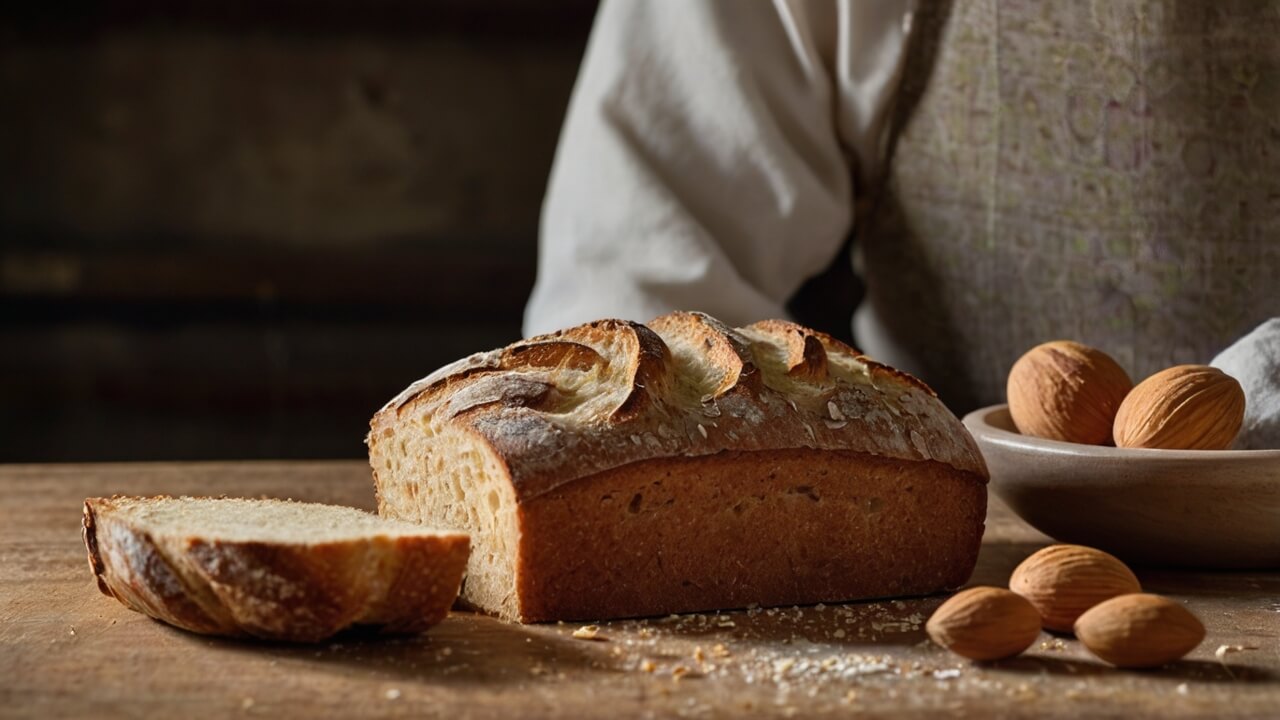
Almond flour sourdough bread offers a multitude of benefits, making it an excellent choice for those seeking a healthier and more versatile alternative to traditional wheat-based breads. Here are some of the key advantages:
Nutritional Advantages:
- Rich in Nutrients: Almond flour is a nutrient-dense ingredient, packed with vitamins, minerals, and healthy fats. It is an excellent source of vitamin E, manganese, magnesium, and fiber, contributing to a well-rounded diet.
- High in Protein: Unlike wheat flour, almond flour is rich in plant-based protein, providing a boost of essential amino acids to support muscle growth and repair.
- Low in Carbohydrates: For those following a low-carb or ketogenic diet, almond flour sourdough bread is a game-changer. With significantly fewer carbohydrates than traditional bread, it allows you to enjoy the taste and texture of sourdough without derailing your dietary goals.
Dietary Accommodations:
- Gluten-Free: One of the most significant benefits of almond flour sourdough bread is its gluten-free nature. This makes it an excellent option for individuals with celiac disease, gluten intolerance, or those following a gluten-free lifestyle.
- Grain-Free: In addition to being gluten-free, almond flour sourdough bread is also grain-free, catering to those with grain sensitivities or following a grain-free diet for personal or health reasons.
- Keto-Friendly: With its low-carb and high-fat content, almond flour sourdough bread fits seamlessly into a ketogenic diet, providing a satisfying and nutritious bread option.
Flavor Profile:
- Nutty and Rich: Almond flour imparts a delightful nutty flavor to sourdough bread, adding depth and complexity to the taste. The natural oils in almond flour also contribute to a rich and satisfying texture.
- Versatile: While almond flour sourdough bread has a distinct flavor, it remains versatile enough to complement a wide range of toppings and fillings, from savory to sweet.
With its impressive nutritional profile, dietary accommodations, and delectable flavor, almond flour sourdough bread is a versatile and wholesome choice for health-conscious bakers and bread enthusiasts alike.
Storing and Serving Almond Flour Sourdough
Proper storage is crucial to preserve the freshness and quality of your almond flour sourdough bread. Unlike traditional wheat-based breads, almond flour sourdough has a shorter shelf life due to its lack of preservatives and higher fat content. However, with the right storage techniques, you can enjoy your delicious creation for several days.
Shelf Life and Storage Tips
At room temperature, almond flour sourdough bread will typically stay fresh for 2-3 days. To extend its shelf life, consider the following storage methods:
- Refrigeration: Almond flour sourdough can be stored in the refrigerator for up to 5-7 days. Wrap the bread tightly in plastic wrap or place it in an airtight container to prevent it from drying out.
- Freezing: For longer-term storage, freezing is the best option. Wrap the bread tightly in plastic wrap or aluminum foil, and place it in a freezer-safe bag or container. Frozen almond flour sourdough can last for up to 3 months. To thaw, simply remove it from the freezer and let it come to room temperature before serving.
Serving Suggestions and Pairings
Almond flour sourdough bread has a rich, nutty flavor that pairs beautifully with a variety of toppings and accompaniments. Here are some delicious serving suggestions:
- Spreads: Complement the nutty taste with nut butters, avocado mash, or your favorite jam or preserves.
- Cheese: The bold flavors of aged cheeses, such as cheddar, Parmesan, or blue cheese, create a delightful contrast with the almond flour sourdough.
- Cured Meats: Thinly sliced prosciutto, salami, or chorizo make for a satisfying and protein-rich pairing.
- Soups and Stews: Use almond flour sourdough for dipping or as a side to hearty soups, stews, and chilis.
- Salads: Toast or grill slices of almond flour sourdough and use them as croutons in your favorite salad.
Remember, almond flour sourdough bread is a versatile and flavorful option that can be enjoyed at any meal or as a snack. Experiment with different toppings and accompaniments to find your perfect combination.
Conclusion
Almond flour sourdough bread is a game-changer for those seeking delicious, nutritious bread that accommodates various dietary preferences. Whether you’re following a low-carb, keto, grain-free, or gluten-free lifestyle, or simply looking to experiment with alternative flours, these recipes offer a unique twist on the classic sourdough.
The nutty flavor and tender crumb of almond flour sourdough bread provide a satisfying and wholesome alternative to traditional wheat-based loaves. By mastering the art of baking with almond flour, you can enjoy the beloved taste of sourdough while reaping the benefits of a low-carb, high-fiber, and nutrient-dense bread.
We encourage you to dive into these recipes and unleash your creativity in the kitchen. Don’t be afraid to experiment with different toppings, mix-ins, or even create your own variations. Embrace the journey of baking with almond flour, and savor the rewarding experience of crafting homemade sourdough bread tailored to your dietary needs.
Share your almond flour sourdough creations with us on social media using the hashtag #AlmondFlourSourdough. We can’t wait to see your beautiful loaves and hear about your experiences with these recipes.
And for more inspiration and expert guidance on alternative baking, be sure to subscribe to our newsletter. We’ll keep you updated with the latest recipes, tips, and trends in the world of gluten-free, low-carb, and grain-free baking.

